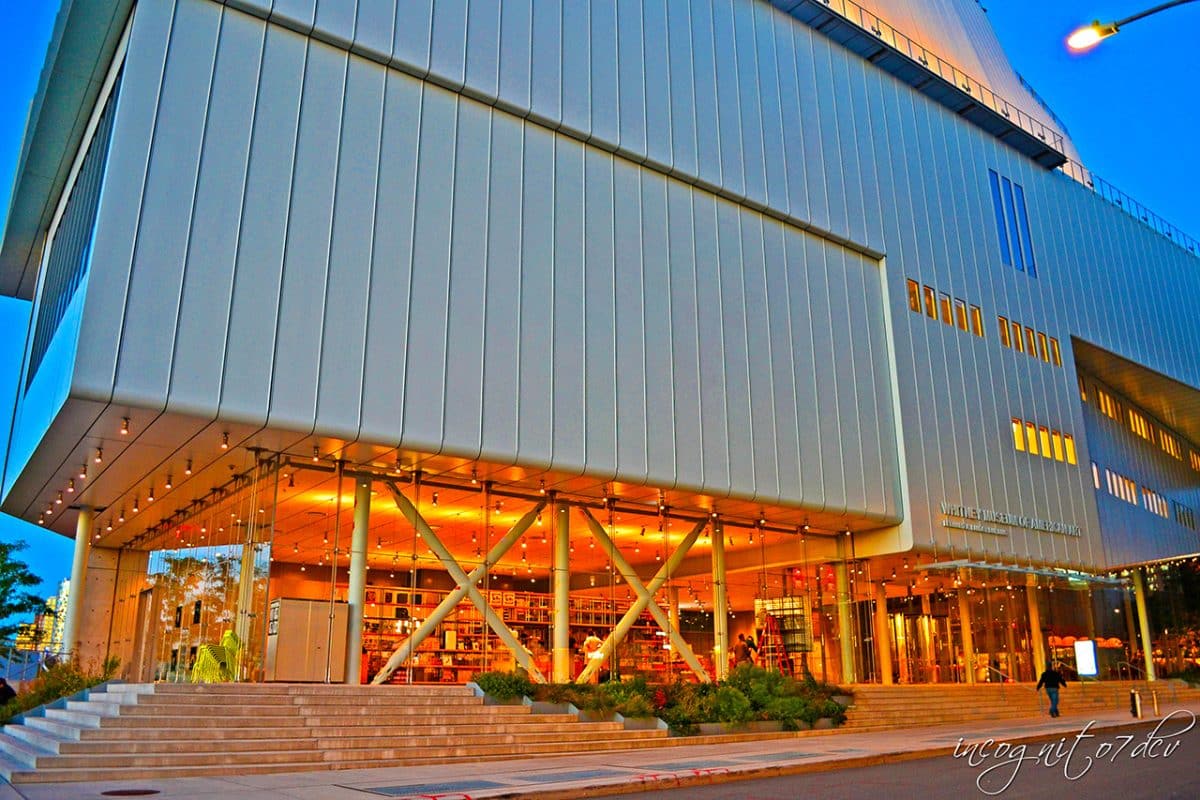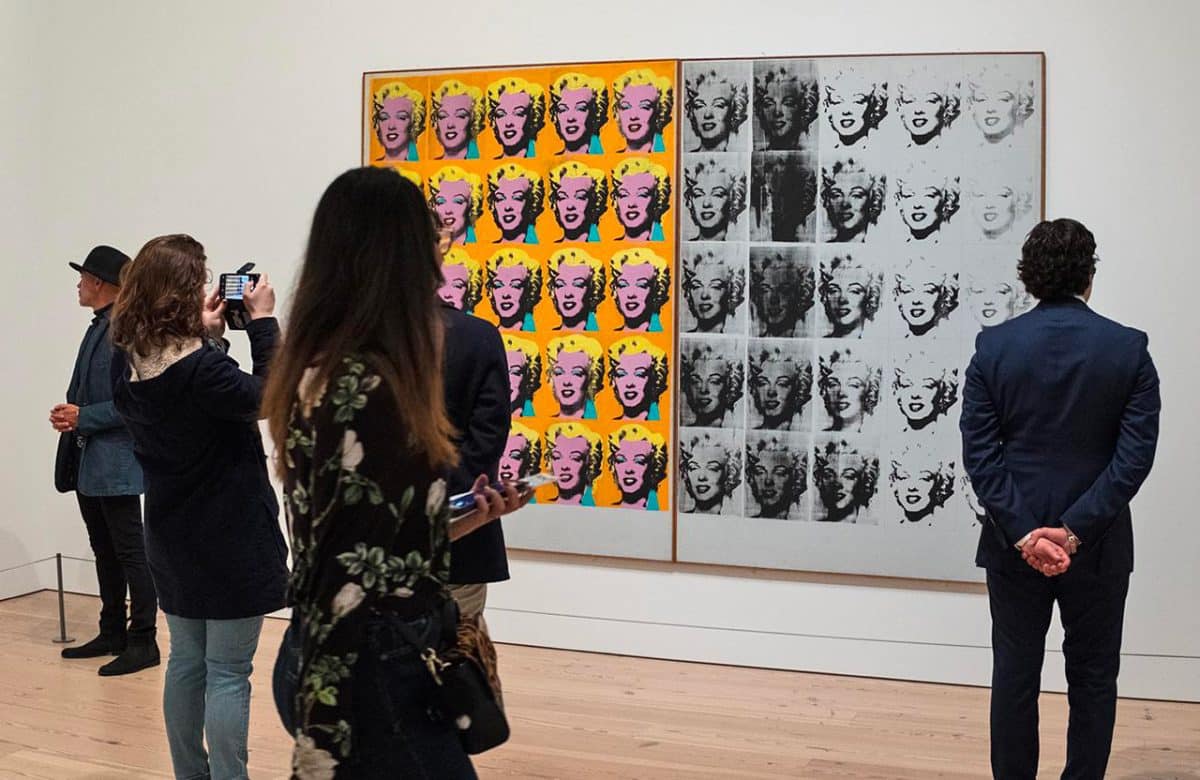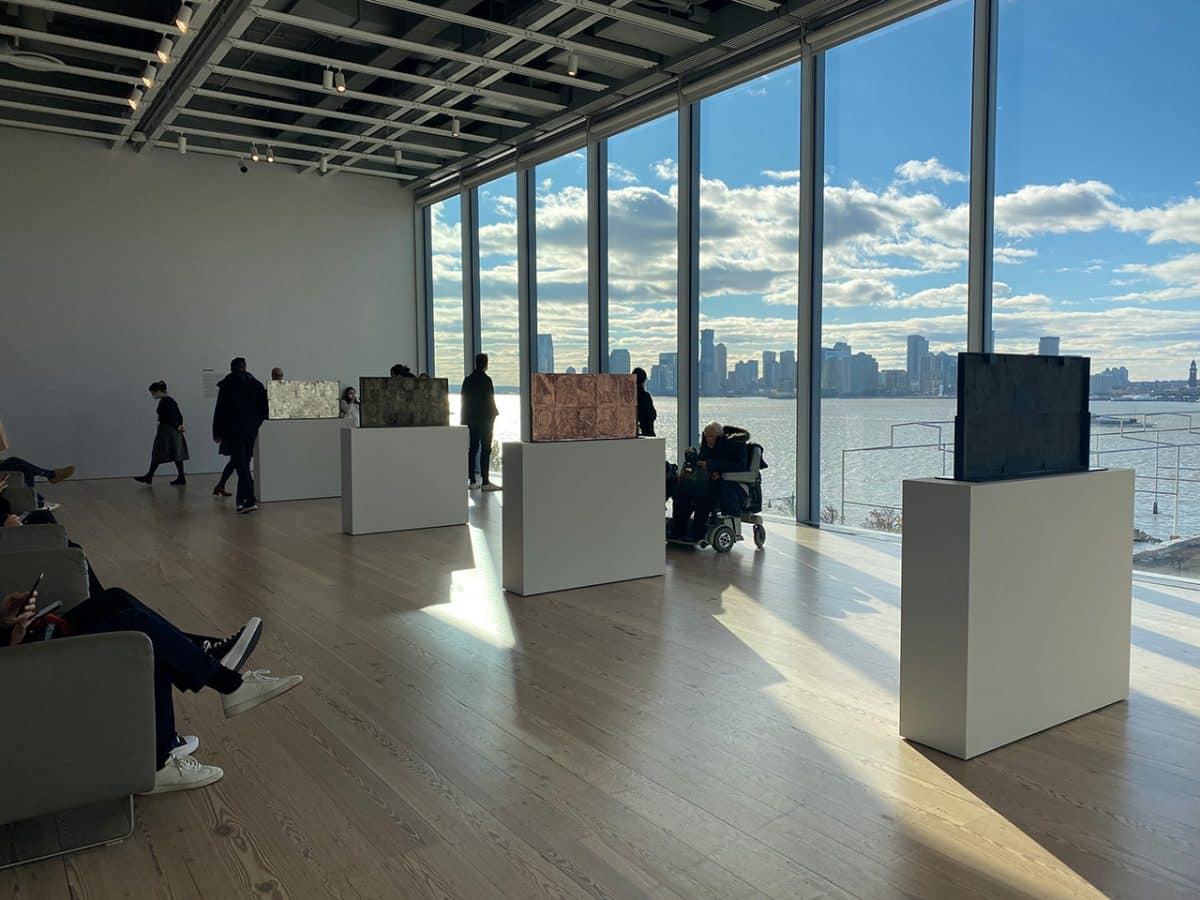On a trip to New York, major museums such as the Metropolitan Museum of Art, MoMA and the Guggenheim are often at the top of the must-see list. However, there is another place that deserves your full attention: the Whitney Museum of American Art. Often overlooked by tourists, this museum in the trendy Meatpacking District represents a unique immersion in contemporary American art. It’s the perfect opportunity to meet artists who are less well known in Europe, while admiring the extraordinary architecture designed by Renzo Piano. In a building with a futuristic design that does not go unnoticed, the Whitney offers a complete experience that goes far beyond a simple museum visit.
The history of the Whitney Museum
The artist and patron of the Whitney Museum
Gertrude Vanderbilt Whitney was a relatively renowned sculptor and a well-informed collector. Very early on, she became a patron of the arts, opening the Whitney Studio Club (1918), a cultural space based in New York where she exhibited the works of avant-garde and totally unknown American artists.
Assisted by Juliana Reiser, Whitney collected nearly 700 works of American art. In 1929, she decided to donate them to the Metropolitan Museum of Art, which declined. At the same time, Whitney noticed that the recently opened Museum of Modern Art (MoMA) was focusing on modern art from Europe.
She decided to start her own collection of exclusively American modern works. Two years later, she opened her museum on 8th Street, in Greenwitch Village, in a large building spanning three city blocks, a reform that was the work of architect Noel L. Miller.
The evolution of the museum
Until 2014, the museum was located on Madison Avenue on the Upper East Side. 2015 marked a major turning point with its move to the Meatpacking District, between the famous High Line and theHudson River. This new strategic location has enabled the museum to reinvent itself while remaining true to its original mission: to shine a spotlight on under-recognised American talent.
Over the decades, the Whitney has forged a reputation as a pioneer in the art world. It was the first museum to exhibit an artist specialising in video art, Nam June Paik, in 1982. The institution has distinguished itself by organising the first retrospectives of now renowned artists such as Jasper Johns, Cy Twombly and Cindy Sherman. Today, its collection has grown considerably to more than 25,000 North American works from the 20th and 21st centuries, created by some 3,000 ‘living’ artists.
Architecture and organisation of the building
The architecture of the Whitney Museum is a work of art in itself. Designed by the famous architect Renzo Piano, the building is characterised by its bold design and resolutely contemporary lines. Its asymmetrical silhouette and vast outdoor terraces make it a visual landmark in New York’s urban landscape.
The museum is spread over 8 floors, each with a specific function. On the ground floor (Floor 1), visitors are welcomed in a vast space that includes a ticket office, shop and restaurant. The lobby gallery is located on this level, and is accessible free of charge without a ticket – a great opportunity to familiarise yourself with the spirit of the place.
The third floor houses the Education Centre, a multi-purpose space including a theatre for events, lectures and shows. A library and reading rooms complete this space dedicated to learning and sharing knowledge.
Floors 5 to 8 form the heart of the museum, with their exhibition galleries organised chronologically. The rooms are remarkably spacious and bright, designed to showcase works that are sometimes monumental. Each level has its own terrace offering different views of the city.
The highlight of this vertical tour is undoubtedly the rooftop, the museum’s true architectural gem. This roof terrace features not only a restaurant with outdoor tables, but above all an exceptional panoramic view of Manhattan.
The terraces: a unique architectural asset
The Whitney ‘s terraces are not simply outdoor spaces, but an integral part of the museum experience. They provide visual breathing space between the exhibition rooms and allow visitors to appreciate the museum’s urban context. Colourful seats are arranged on the terraces, inviting visitors to take a contemplative break and look out over the city.
From the top of these terraces, the panorama extends over the Meatpacking District, the High Line and theHudson River, and in the distance you can see iconic monuments such as theEmpire State Building and One World Trade Center. The terrace on the top floor, which is accessible even without eating in the restaurant, certainly offers one of the most original and least known viewpoints in New York.

Collections and exhibitions
The artistic richness of the Whitney Museum lies in its exceptional collection of contemporary American art. With over 25,000 works, the museum obviously cannot present everything at once. This is why exhibitions are regularly renewed, offering regular visitors an ever-changing experience.
The permanent exhibition galleries, located on the 1st and 2nd floors, present a selection of emblematic works. As for the upper floors, they are organised according to a precise chronology:
- 8th floor: period 1910-1940
- 7th floor: period 1925-1960
- 6th floor: period 1950-1975
- 5th floor: period 1965 to the present day
For a coherent visit, many visitors choose to start at the top of the building and work their way down, following the thread of the history of American art from the beginning of the 20th century to the present day.
The range of media represented is impressive: paintings, sculptures, prints, films, photographs, video installations and more. The styles vary considerably, with some works being purely aesthetic while others carry a more committed political or social message.
Among the artists exhibited are famous names such as Andy Warhol and Edward Hopper, some of whose works have become emblematic of American art. But one of the Whitney ‘s strengths is to present lesser-known or emerging artists alongside these giants, in keeping with its original mission.
Temporary exhibitions: a dynamic programme
The Whitney ‘s temporary exhibitions bear witness to its ongoing commitment to contemporary art. The programme changes according to the trends and themes explored, reflecting the vitality of the American art scene.
The museum is known for its avant-garde stance and its willingness to show works that can sometimes shock the public. This very contemporary orientation is what makes the museum so unique, even if it may not appeal to all visitors, particularly those who prefer more classical art.
To keep up to date with current and forthcoming exhibitions, visit the museum’s official website (www.whitney.org) before your visit.

The visiting experience
Visiting the Whitney Museum is much more than a simple artistic tour. It’s a holistic experience that engages all the senses and can take up an entire half-day.
Ideally, start your visit on the upper floors to follow the chronological development of American art. The spacious rooms allow you to stand back from the sometimes monumental works. The building’s careful acoustics create an atmosphere that’s conducive to contemplation, despite the museum’s busy schedule.
Don’t hesitate to take a break on the various terraces to air your eyes and your mind between two exhibition rooms. These breathtaking moments with a view over Manhattan are an integral part of the architectural concept and add considerably to the experience.
On Friday evenings, take advantage of the extended opening until 10pm to enjoy a special experience: watch the sunset from the museum’s terraces and then admire the lights of the city as they gradually come on. This nocturnal atmosphere adds a whole new dimension to your visit.
For the full experience, allow around 2 hours for your visit, but you can spend as much time as you like. If you’re feeling tired, the museum’s restaurants offer the chance to take a gourmet break while enjoying the exceptional setting.

A gastronomic experience from on high
The dining options at the Whitney are not just a side service but part of the overall experience. The restaurant on the ground floor offers quality cuisine in a contemporary setting in perfect harmony with the spirit of the place.
But it is undoubtedly the rooftop restaurant that offers the most memorable experience. Dining on the terrace with a panoramic view of New York transforms a simple meal into an exceptional moment. Even without a reservation for the restaurant, you can access the terrace and enjoy the view with just a drink.
This gastronomic dimension, combined with the architecture and art collections, makes the Whitney a place of total culture, where art dialogues with the city, gastronomy and design in a perfectly integrated experience.
Practical information
Here is all the essential information you need to plan your visit to the Whitney Museum:
Opening times and prices
The museum is open
- Monday, Wednesday, Thursday, Saturday and Sunday: 10.30am to 6pm
- Friday: 10.30am to 10pm (night-time)
- Closed on Tuesday
Admission charges :
- Adults: between €27 and €31 (approx. $30)
- Children (0-18 years): Free
- Seniors and people with reduced mobility: $24
To make the most of your visit, we strongly advise you to book in advance. This will help you avoid queues, which are particularly long during the high tourist season.
Good deals
There are a number of money-saving tips:
- The lobby gallery on the ground floor is accessible free of charge, without a ticket. It’s an excellent introduction to the museum.
- Every Friday from 7pm to 10pm, admission is free (“Pay-What-You-Wish”). Please note: tickets for this option are limited and advance booking is strongly recommended.
- Combine your visit with a walk on the High Line, which starts almost at the foot of the museum, for a day of art and architecture at no extra cost.
Location and access
The Whitney Museum is conveniently located at 99 Gansevoort Street, New York, NY 10014, in the vibrant Meatpacking District.
There are several options for getting there by metro: Lines 1, 2, 3: get off at 14 St. Once there, the museum is easy to spot thanks to its distinctive architecture.
Its strategic position at the southern entrance to the High Line and close to Chelsea Market means that you can combine several visits to this very attractive area of Manhattan.
Various bus routes stop near the museum (the M14A, M11, M7 or M12).
If you’re travelling by car, you can park in Apple Parking, where a visit to the museum entitles you to a $10 discount.
The Whitney Museum of American Art is a refreshing alternative to the classic New York tourist circuit. If this is your first trip to the city, you may prefer to visit the iconic museums such as the MET or MoMA first. But on a second visit, or if you’re looking to get off the beaten track, the Whitney is a must-see.
What makes this museum so unique is the perfect blend of a first-rate collection of contemporary American art, bold architecture by Renzo Piano, and an all-encompassing experience that includes fine dining and exceptional panoramic views.
The Whitney is more than just a museum: it’s a vibrant place where art interacts with the city, where the terraces provide visual breathing space between the exhibition rooms, and where each visit offers new discoveries thanks to the regular renewal of the collections on display.
With its ideal location at the foot of the High Line and close to Chelsea Market, it fits perfectly into an itinerary exploring the west side of Manhattan. Whether you are a seasoned art lover or simply curious, the Whitney Museum offers a memorable experience that is both culturally enriching and visually spectacular.


